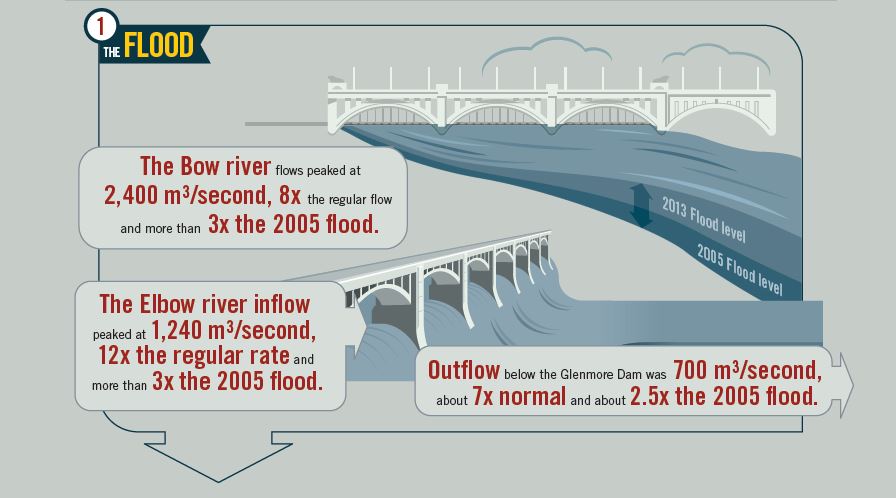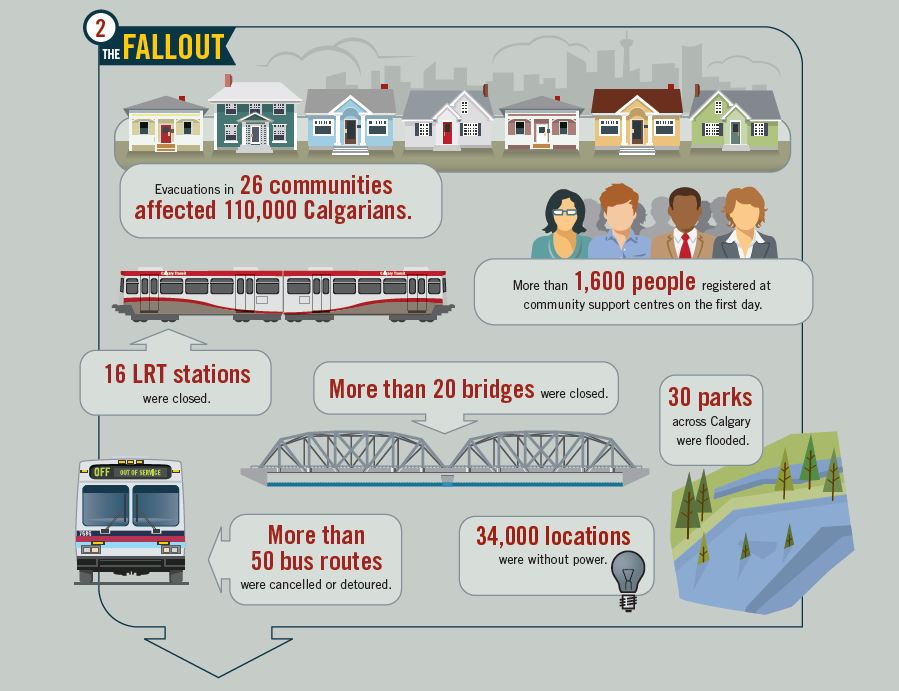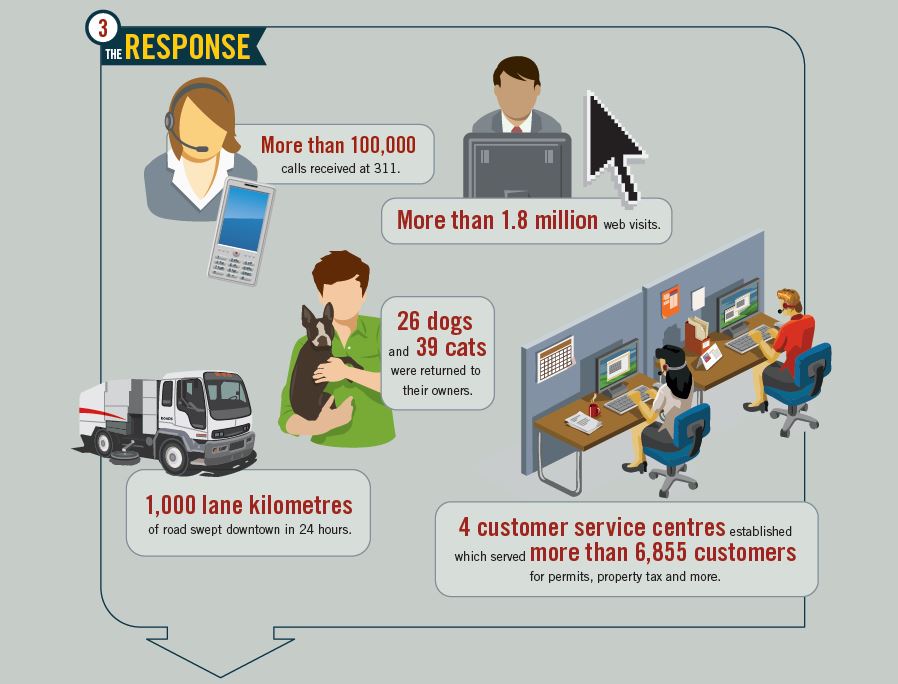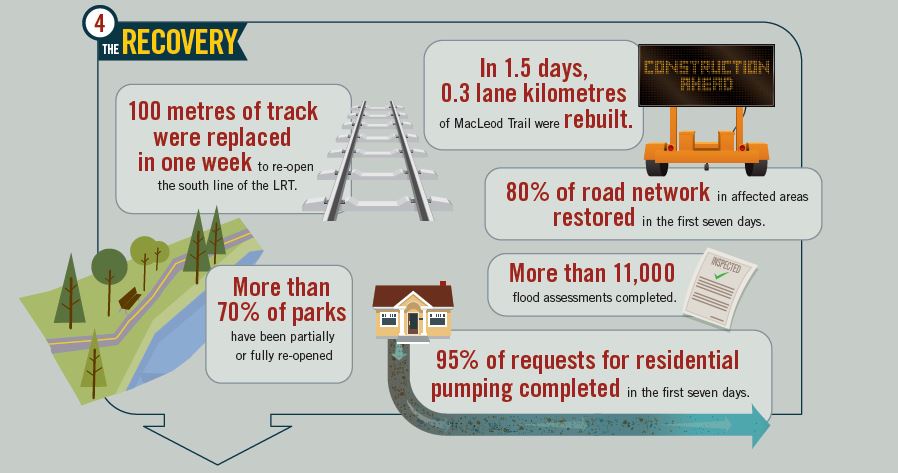Flooding in Calgary - Flood of 2013
How did the flooding start?
Heavy rainfall on the melting snowpack in the Rocky Mountains combined with steep, rocky terrain caused rapid and intense flooding in southern-Alberta watersheds.
As the waters rushed towards Calgary, The City issued a flood warning, activated the Municipal Emergency Plan, declared a state of local emergency and gave an evacuation notice for communities at risk. About 80,000 people were evacuated over the course of the flood.
The flood in numbers:
- The Bow River flows peaked at 2,400 cubic metres per second which is eight times its regular flow rate.
- The Elbow River inflow peaked at 1,240 cubic metres per second which is 12 times its regualr flow rate.
- Outflow below the Glenmore Dam was 700 cubic metres per second about seven times its normal rate.
What was the impact of the flood?
The floods of June 2013 were the largest in Calgary since 1897. Sadly, one Calgarian's life was lost and there was as much as $6 billion in financial losses and property damage across southern Alberta.
Evacuees and people whose homes were flooded faced trauma, loss, and either rebuilding or the permanent loss of their home. Flooding disrupted businesses, damaged critical infrastructure and led to power outages across Calgary.
The impact in numbers:
- Evacuations in 26 communities, 110,000 affected
- More than 1,600 people register for support on first day
- 16 LRT stations closed
- More than 20 bridges were closed
- 30 parks across Calgary were flooded
- More than 50 bus routes were cancelled
- 34,000 locations were without electricity
How did The City respond to flooding?
To respond to flooding, we lowered the water level in the Glenmore Reservoir to increase the amount of water captured by the reservoir to reduce flooding without impacting the treatment plant’s ability to supply safe drinking water quality.
Temporary flood barriers were built at many locations throughout the city. Without these flood responses, damage to Calgary would have been much more devastating.
Despite these measures, the river over topped its banks on the Elbow and Bow Rivers. Extensive emergency response was required across 32 communities in Calgary, and the downtown was inaccessible for days.
Significant damage to both private and public property occurred by overland flooding, rising groundwater, storm water back-up and sewer back-up.
The response in numbers:
- More than 100,00 calls received at 311
- More than 1.8 million web visits to calgary.ca
- 26 dogs and 39 cats returned to their owners
- 1,000 km of road swept downtown in 24 hours
- Four customer service centres established which served more than 6,855 customers for permits, property tax and more
The cost of the 2013 flood
The emotional and health impact of the 2013 flood was significant. The costs continue to be shared by individuals, private companies, insurers, and the taxpayers of The City of Calgary, the Government of Alberta and the Government of Canada.
The full impact of the flood across Alberta has been assessed at approximately $5 billion. The City’s Flood Recovery Task Force identified a total of $409 million in damages to City of Calgary infrastructure alone.
Other costs include $55 Million to cover the emergency response for Calgary, and $323 million for recovery costs. Since 2013, The City and Government of Alberta have invested an additional $150 million in flood mitigation and resilience projects to help mitigate the risk of future flooding.
The recovery in numbers:
- 100 metres of LRT track were replaced on the south line
- In 1.5 days, 0.3 km of MacLeod Trail was rebuilt
- 80% of road network restored in first seven days
- More than 11,000 flood assessments completed
- More than 70% of parks partially or fully re-opened
- 95% of requests for residential pumping completed in first week
Click image to see a full size picture.
How often do floods like 2013 happen in Calgary?
Although the 2013 flood was the largest in recent memory, it was within the natural range for the Bow River. Our records indicate that floods of similar size occurred in 1879, 1897 and 1902.
Other large floods occurred in 1929 and 1932 on both the Elbow and the Bow Rivers. No floods of the magnitude of the 2013 event have occurred since 1932.
Images from the 2013 flood
During peak flows, the Elbow River flowed across the bridge deck and left debris piled up on the walkway.
At its peak – the flood levels inundated the lower Centre Street Bridge, adjacent pathways and areas of Chinatown.
Through reservoir management, City staff were able to reduce peak flow downstream of the dam by 40%.
Construction of a temporary barrier helped protect Mission and the Beltline; however some were impacted by stormwater and groundwater seepage.
Mission was among the first communities to experience flooding and one of the first to be evacuated.
Some riverbanks, like these in Inglewood, experienced large amounts of erosion.
The flood event caused damage to more than 30 km of riverbank along the Bow River.
Enmax substation #32 was surrounded by floodwaters. A flood wall has since built.
Elbow River floodwater spilled along 22 Ave SW and across Macleod Trail.
One of the many roads in Calgary – this one is located behind Stampede Park - which were washed out as a result of the flooding.
The water was about three metres deep in the rodeo infield, and at least the first ten rows in the Saddledome were underwater.
The Elbow River, which flows behind Stampede Park, rose high enough to top the bridge into the Park, flooding the livestock barns.
Rotating shifts meant the Emergency Operations Centre was staffed 24/7 until the flood subsided.
As the flood grew, many roadways close to the rivers became inundated with water. Mayor Nenshi asked everyone to stay home and do their best to stay safe.
In some communities boats replaced cars as the safest means of transportation.
The new Fourth Street SE underpass flooded with approximately ten metres of water.
Damage to an Elbow River Pedestrian bridge. Three pedestrian bridges on the Elbow River required complete replacement following the flood.
Huge amounts of debris accumulated within the river and the flooded communities requiring significant removal efforts to Calgary landfills





